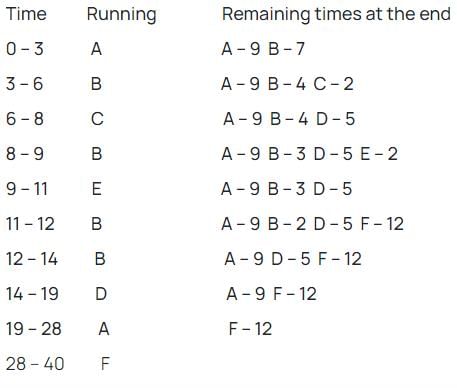Test: Operating System - 2 - Computer Science Engineering (CSE) MCQ
15 Questions MCQ Test - Test: Operating System - 2
The main function of the dispatcher (the portion of the process scheduler) is:
Consider a system has hit ratio as h%. Average access time to service a page fault is s milliseconds and average effective memory access time is e in milliseconds. What is the memory access time in microseconds (m is considered with service time)?
Suppose there is a paging system with a translation lookaside buffer. Assuming that the entire page table and all the pages are in the physical memory, what is the effective memory access time in ms if it takes 5 msec to search the TLB and 70 msec to access physical memory? The TLB hit ratio is 0.8.
Which of the following statements are true?
(a) External Fragmentation exists when there is enough total memory space to satisfy a request but the available space is contiguous.
(b) Memory Fragmentation can be internal as well as external.
(c) One solution to external Fragmentation is compaction.
Consider a computer system having R resources of the same type and these resources are shared by 6 processes that have maximum demands of 7, 5, 3, 8, 4, 6 respectively. Then for what minimum values of R, the system will not be in deadlock?
Which of the following statement is not true about round – robin scheduling?
Which of the following is TRUE about user-level threads and kernel-level threads?
S1: Typically if a user-level thread is performing blocking system call then the entire process will be blocked
S2: Kernel level threads are designed as dependent threads
S3: Every thread has its own register and stack
Which of the following statement is correct about cascading termination of a child process?
Consider a hypothetical system with byte-addressable memory, 64-bit logical addresses, 8 Megabyte page size and page table entries of 16 bytes each. What is the size of the page table in the system in terabytes?
Given the Burst Time (BT) of 4 processes P1, P2, P3, and P4 as BT(t1, t2, t3, t4) – (4, 8, 6, 7), smoothening factor(α) – 0.5, and T1 = 10, what will be the burst time of process P5 for shortest Job first scheduling, using the technique of exponential averaging?
Suppose that jobs arrive according to the following schedule :

Now give the sequence of the processes as they gets share of CPU if the scheduler used is Shortest Remaining Time First.
The probability that a process spends its time in performing I/O operations is 50%. In a multi programmed operating system environment, if there are 4 processes in memory at once, then the probability that all processes are waiting for I/O and the system utilization are respectively
The process executes the code where x is an integer and x is initialized to 10
while(--x){
fork();
if(x == 2)
break;
}
The total number of child processes created is
A system has 12 identical resources and Y processes competing for them. Each process can request at most 3 resources. Which one of the following values of Y could lead to a deadlock?


















